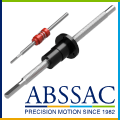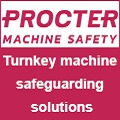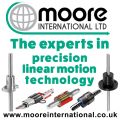
Posted to News on 11th Dec 2012, 17:46
Explaining the different types of AC electric motor
The myriad motor technologies all have partially overlapping functionalities, so how does an engineer choose the right type of motor for a given application? Jerry Hodek, Technical & Operations Director at Regal, offers this guide for applications requiring precisely metered torque, speed or positioning.
Popular motors for industrial applications include AC induction motors, permanent magnet AC (PMAC) motors and servomotors. The first is lowest in price and suitable for many, many applications; the last is the most expensive, but its performance is truly astonishing.
The induction motor is the workhorse of industry. Many tens of millions are installed around the world, driving a huge range of different types of machinery. Their construction and operating principles are relatively simple. Normally they are fixed-speed devices, but when used with electronic variable speed inverter drives are controllable to a considerable level of accuracy.
An induction motor's stator consists of a stack of thin, highly permeable steel laminations with slots; the laminations are secured in a steel or cast-iron frame that provides a mechanical support. The windings that accept the external power supply are run through the slots. The rotor resembles a cage consisting of aluminium or copper conducting bars connected by short-circuiting end rings "" hence the nickname squirrel cage for induction motors. The rotor also has laminations; radial slots around the laminations contain the bars. The rotor turns when the moving magnetic field induces current in the shorted conductors, and the rate at which it rotates is the motor's synchronous speed.
Synchronous speed is the fastest theoretical speed a motor can spin "" when the rotor spins at the same speed as the motor's internal rotating magnetic field. In practice, an induction motor is an asynchronous motor (in which the rotor lags field speed), so its rotor must spin more slowly than the field. The difference between the field speed and the real rotor speed is slip. This allows the induction of rotor current to flow, and produce torque to drive a load while overcoming internal losses.
There are many instances of induction motors running almost faultlessly for years at a time, but possible problems relate to their naturally fixed speed output; overheating causing degradation of internal components; large inrush currents on start-up; and an intolerance to stop/start duty cycles. Thus while they are suitable for many applications, there are some where a different motor technology is preferable.
Permanent magnet motors
Permanent magnet AC (PMAC), or brushless, motors do not rely entirely on current for magnetisation; additional magnets are mounted on or within the rotor to give extra power. The additional magnets are powerful rare earth magnets (typically 50-200 per cent stronger than a ferrite magnet).
Until relatively recently rare earth magnets were very expensive, which held back take-up of PM motors; however, prices have fallen and the motors are becoming more and more popular. They are said to offer near-servo levels of performance at lower cost.
Pure PM motors must always be used with a dedicated inverter drive, (although there are some hybrids on the market that will start and operate at a fixed speed without one), but while this adds to the cost and complexity it does give variable speed capability. It is also notable that a PM motor is highly energy efficient when used with a drive.
There is a problem to overcome with PM motors. The permanent magnets can cause the rotor's spinning motion to become jerky. At low speed this is manifest as cogging, and at higher speed as a torque ripple. This can cause noise, vibration and non-uniform rotation, but can be overcome by a number of methods.
In addition, the back EMF (electromotive force) created as a PM motor rotates limits its top speed. This is not usually a problem because users simply select a motor with adequate speed for the job in hand or a gear reducer, but it is possible for the electronic drive to command a speed in excess of the safe limit or for the load to back-drive the motor to high speed, either of which can cause damage. It is also possible for the permanent magnets to lose their strength if subject to prolonged heat or over-currents.
Servomotors
Servomotors are wound with two phases, set at right angles to each other. A fixed reference winding is excited by a fixed voltage source, while a variable control voltage from a servo-amplifier excites the second winding.
Typically the windings are designed with the same voltage-to-turns ratio, so that power inputs at maximum fixed phase excitation, and at maximum control phase signal, are in balance.
Servomotors are notably smaller than other motors with similar output, while the reduced rotor inertia makes for quicker response. Also, their nearly linear speed-torque characteristic means they can be controlled very accurately.
Servomotors are always installed with a permanent feedback device which constantly monitors the rotational position of the output shaft, counting the number of rotations backwards and forwards, to an accuracy of tiny fractions of a degree. This data stream can be used to note the actual position of the shaft and is fed into an electronic controller or servo-amplifier and used to monitor and the actual position of the shaft. If the shaft slips from the desired position, the feedback can be used to adjust it on the fly. Other types of motor can also use a feedback device if the application demands it, but it is not essential.
Thus we see that servo motors are compact, very powerful, very high speed, very accurate and very controllable. But it does not take a genius to work out that they must have a downside - and that is price! As a rule of thumb a servomotor may cost 10 times the price of an equivalent-sized induction motor, then installing and commissioning one will also be far more involved (i.e. expensive).
Selection
The dynamic capabilities of the different types of electric motor varies widely, as does their price and the technical effort required to install and maintain them. In many applications selecting the most appropriate motor will be straightforward; the performance required will be comfortably within the capability spectrum of one type or another.
However, there will also be cases where the requirements are at the top of one motor's spectrum and the bottom of another's, particularly the moving target of energy efficiency, in which case you probably end up choosing between cost and reliability. In such cases some expert advice may be useful, and this is best sought from a supplier who offers a wide range of motor types as they will have broad ranging expertise and give objective guidance.
For more information about selecting AC electric motors, please visit www.rotor.co.uk/.
Unit 8, 16 Everitt Close
Denington Industrial Estate
NN8 2QF
UNITED KINGDOM
+44 (0)1933 230900

































